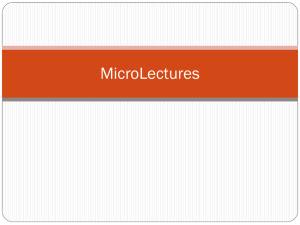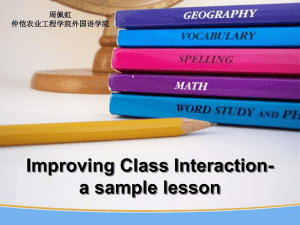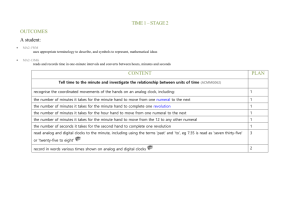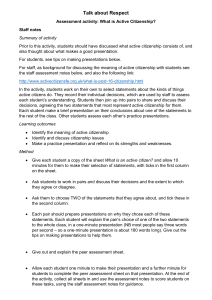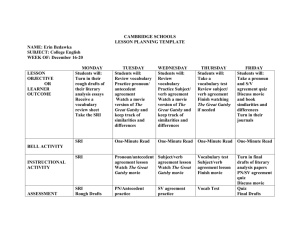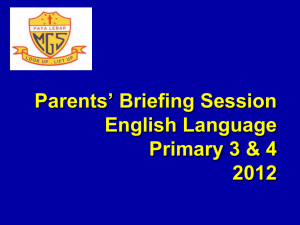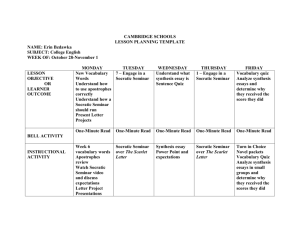Teaching the First-Year Seminar:
advertisement
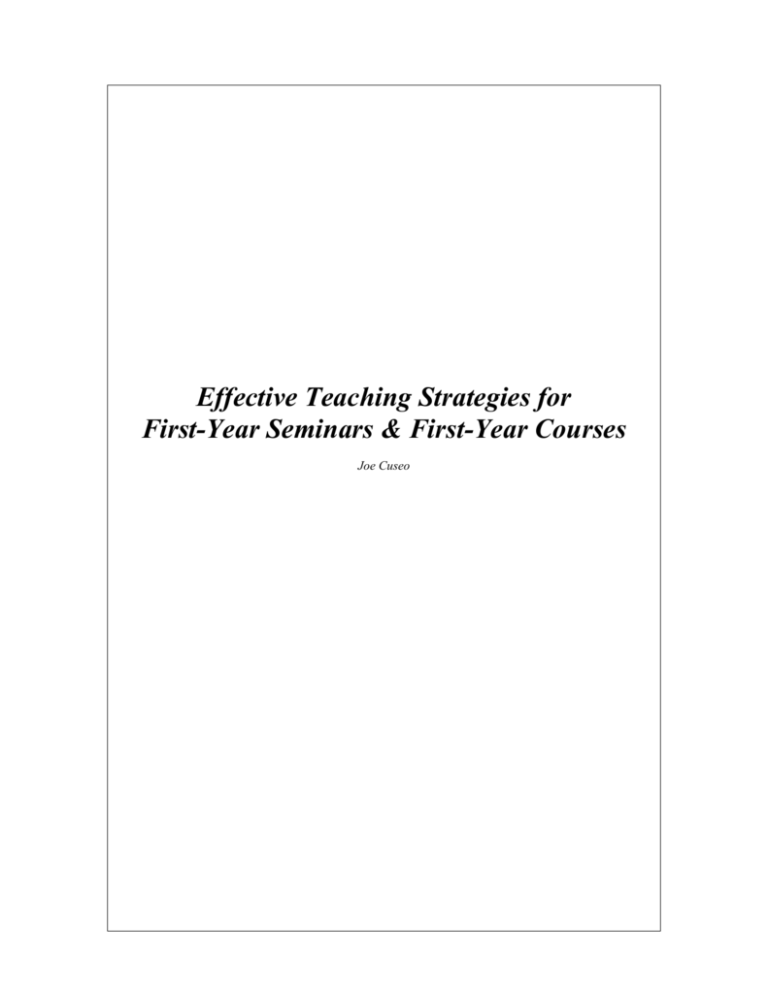
Effective Teaching Strategies for First-Year Seminars & First-Year Courses Joe Cuseo 2 From Theory to Practice Teaching Strategies for the First-Year Seminar Making Four, Key Student Success-Promoting Connections 1. The Student-Instructor Connection 2. The Student-Course Connection 3. The Student-Student Connection 4. The Student-Campus Connection ------------------------------------------------------------------------------------------------------------ I. The Student-Instructor Connection 1. Initiating the Student-Instructor Connection: Establishing Rapport with Your Students during the First Weeks of Class * Key Strategies: - Learning Your Students’ Names: Effective Strategies - Learning about Your Students: The “Student Information Sheet” 2. Sustaining the Student-Instructor Connection: Maintaining Rapport with Your Students throughout the Term * Key Strategies: - Sharing Personal Anecdotes & Success Strategies - One-Minute Papers - Prompted Journals ------------------------------------------------------------------------------------------------------------ 3 II. The Student-Course (Subject) Connection 1. Initiating the Student-Course (Subject) Connection: Igniting Student Interest and Involvement in the Course during the First Weeks of Class * Key Strategies: - Motivational Titling of the Course and Course Topics - Building a Case for Course Relevance - Soliciting Student Input & Choice with Respect to Course Topics 2. Sustaining the Student-Course Connection: Maintaining Student Interest and Involvement in the Course throughout the Term * Key Strategies: - Posing Open-Ended Questions during Your Class Presentations - Presenting Involvement-Promoting Prompts (e.g., provocative quotes, powerful passages, poignant pictures/images, intriguing artifacts, content-relevant cartoons, engaging games) - Reality-Based/Reality-Simulated Learning Activities (e.g., scenarios and case studies) ------------------------------------------------------------------------------------------------------------ III. The Student-Student (Classmate) Connection Initiating Student-Student (Peer) Connections: Creating a Sense of Community among Classmates during the First Weeks of Class * Key Strategy: Icebreakers (a.k.a., “Community Builders”) - “Classmate Scavenger Hunt” - Paired Interviews (a.k.a., “Three-Step” Interview”) 4 2. Sustaining Student-Student Connections: Maintaining Peer Interaction and Class Community throughout the Term * Key Strategies: - Small-Group Discussion: Pairs, Triads, Quads - Collaborative Learning: reaching consensus in small groups - Cooperative Learning: intentionally-formed learning teams whose work is explicitly designed to ensure collective responsibility (positive interdependence) and individual accountability (personal responsibility). ------------------------------------------------------------------------------------------------------------ IV. The Student-Campus (Resources) Connection 1. Initiating the Student-Campus (Resources) Connection: Igniting Student Interest and Involvement with Key Success-Promoting Campus Resources during the First Weeks of Class * Key Strategies: - Intentional Identification of Course-Relevant Support Services - Course-Integrated Support Services 2. Sustaining the Student-Campus (Resource) Connection: Maintaining Student Interest & Involvement with Key Success-Promoting Campus Resources throughout the Term 5 * Key Strategies: - Bringing Individual Resource Agents to Class as Guest Speakers - Bringing Individual Students to Campus Resources via Course Assignments ≉ 6 THE STUDENT INFORMATION SHEET: A Proactive Strategy for Initiating Teacher-Student Rapport The first and foremost goal in the FYE course should be to establish rapport with your students. Meeting students’ need for acceptance and validation is a necessary precondition for establishing the social-emotional foundation needed for subsequent learning and personal growth. It has been my experience that students begin to care more about learning and become more committed to the learning process when they sense that their instructor cares about them. One way to gain and maintain instructor-student rapport is through use of what I call the “Student Information Sheet.” The sheet contains questions for students to answer, which I’ve divided into six general areas: (1) personal background, (2) future plans, (3) personal abilities, achievements, and distinctive qualities, (4) personal interests, (5) personal values, and (6) course expectations, expectations and interests. (See the list of questions at the end of this exhibit for a specific list of questions relating to each of these six categories.) On the first day of class, I distribute the course syllabus, but do not spend class time systematically reviewing it. Instead, I tell students that their first assignment is to read the syllabus for the next class session and that I prefer that our first meeting together should focus on people, not paper. I tell my class we’re going to take some time to learn about each other before we attempt to learn the subject matter, then project questions related to the aforementioned six areas. I reveal one question at a time, and have students record their answers to each question on a sheet of paper. At the same time students are recording their answers, I write my answers on the board to the same questions (except for those questions that are student-specific, such as class standing). By answering the questions along with your students, I show my class that I trust them well enough to reveal something personal about myself, which in turn, makes them feel more comfortable about revealing more of themselves to me. Also, my answering the questions with them serves to validate the exercise, suggesting that it’s worthy of my time and effort as well. This exercise typically takes about one minute per question, i.e., 40 questions takes approximately 40 minutes. I typically use no more than 30 of the questions, because I want to reserve some class time to collect the information sheets and review students’ names. I like to keep the process moving fairly quickly by advising students that they can use short sentences or single words and phrases to answer the questions (as I do on the board). Also, short and fairly quick responses often seem to capture students’ true thoughts or feelings in response to the question (their “free associations”), as opposed to calculated, socially acceptable responses. After the exercise is completed, I collect each student’s information sheet and use it in the following ways to promote rapport with the class throughout the term. 7 1. On the first day of class, after I’ve collected all the information sheets, I call-out the names of individual students, asking them to raise their hand when their name is called so I can associate their name and face. As I call out their names, I very rapidly jot down a quick word or abbreviated phrase next to the student’s name for later review (e.g., something about a distinctive physical feature or seating spot that can help me remember the student’s face and name). 2. Before the next class meeting, I read all student responses to the questions and highlight one from each student’s sheet that is thought-provoking or stimulating. I come to the second class session with something highlighted on each student’s sheet, and I start class by calling out each student’s name and ask each student in class for a brief elaboration on the item I’ve highlighted (e.g., When did you move from New York to California? When you worked with handicapped children, what type of assistance did you provide?) This shows all students that I’ve taken to time to read their information sheets and am taking an individual interest in each one of them. The short verbal interchange I have with each student also helps me immensely in learning their names, because it allows more eye-contact time than that which occurs during a simple roll call, and it provides a distinctive event or interactive “episode” to which I can relate (associate) their face and name. 3. Throughout the term, I use the information sheet to actively involve individual students in the course. I identify topical interests that individual students mentioned on their information sheets during the first day of class, record the student’s name on a post-it sticker, and then stick it onto my class notes—next to the topic or subtopic that relates to the student’s interest. When that particular topic is covered later in the term, I introduce it by mentioning the name of the student who had expressed interest in that topic on the first day of class. It has been my experience that students perk-up when I mention their name in association with their preferred topic, and they are often amazed by my apparent ability to remember the interests they expressed on the very first day of class at much points later on in the term. Students rarely ask how I managed to remember their personal interests, so they remain unaware of my “crib sheet” strategy. Consequently, they tend to conclude that I have extraordinary social memory and social sensitivity (which is perfectly fine with me). I also use the student information sheet for the following purposes. 4. To make final decisions about what particular topics to cover in the course. I’ll use student interests expressed on the information sheet to help select course topics and subtopics. Although I decide on a set of core concepts or topics to be covered in the course, I use information gleaned from students’ sheets to decide on what other “supplemental” topics I’ll cover. I inform the class that I’ve used their input to help me decide on what topics to include in the course, which gives them a sense of course input and course ownership, which I think serves to enhance their intrinsic motivation. 5. To make personal connections with non-participative or “detached” students. For example, before class, I may strike-up a conversation with a shy student about something from her information sheet. Or, as students leave the classroom at the end of class, I typically stand by the door as they depart. When a quiet or non-participative 8 student is leaving, I’ll quickly ask that student something relating to his information sheet. 6. To connect the course with other courses that students are taking in the same term. One question on the information sheet asks students for their current class schedule. I make note of other courses that students are taking and attempt to relate material in the FYE seminar to their other courses. For instance, when I’m covering mnemonic devices in the seminar, I will use examples for improving memory that apply to content they may be learning in their other classes. 7. To intentionally form small groups or learning teams. For example, I may create homogeneous groups consisting of students with the same career interests, or heterogeneous teams comprised of students from different geographical areas or cultural backgrounds. 8. To personalize written feedback I give to students during the term. For example, if a student initially expressed an interest in joining a student club or finding an on-campus job, I’ll ask about that when I’m providing written feedback on a student’s journal entry or one-minute paper. 9. To prepare for and personalize students’ scheduled office visits. I will look over a student’s information sheet prior to an office visit and refer to something mentioned on the sheet during the student’s office visit. 10. To personalize and enliven the process of returning student assignments in class. Periodically, I look over my students’ information sheets just before going to a class session when I’ll be returning student assignments, and instead of calling out the names of students to come up and retrieve their assignments, I’ll call out some piece of information I remember from their information sheet. For example, I might say: “Will a future occupational therapist from Maryland please come up and pick-up your assignment?” (This demonstrates to students at later points in the term that I still know them well.) 11. To showcase articulate comments and insightful ideas generated by students. I will look for comments and ideas shared by students on their information sheet that may relate to a course topic and display them on a transparency when we get to that particular topic in class. For example, there is a question on the information sheet that asks students for their favorite quote. One student wrote: “When you point your finger at someone else, there are three fingers pointing back at you.” This succinct saying artfully captured the gist of projection—a defense mechanism that I cover in class under the topic of self-efficacy. When I reached the point in the course when I discussed that defense mechanism, I created an overhead transparency that contained the student’s quote along with her name and used it to introduce the concept of projection. This practice serves to validate students’ ideas, plus I’ve found that students really seem to get a charge out of being quoted; perhaps it makes them feel like an important person whose ideas are worthy of public announcement and consumption. 9 12. To personalize test questions that I use on exams. I use the information sheets to construct test questions relating to individual students’ interests. For instance, in a first-year seminar test covering the topic of major/career choice, I include student names on questions that relate to their particular major or career interest (e.g., “Jennifer P. is interested in both Art and Business, so she decides to major in Art and minor in Business. Approximately how many courses in Business will she need to complete a minor in this field?”). Conclusion It’s been my experience that when students are aware that you care about them, they care more about you and what you’re trying to teach them. Caring about your students also tends to help them become more intrinsically motivated, more actively involved in the learning process, more willing to take intellectual risks, and more likely to respond positively (less defensively) to your constructive feedback. The student information sheet has proven to be my most effective strategy for demonstrating to students that I care about them as individuals. It has proven to be well worth the “sacrifice” of lost content coverage on the first day of class because it creates a much more favorable first impression of the course than rushing into the course content. It is also a teaching tool that has the versatility to be used in multiple ways—throughout the term—to connect students with the course material, with the course instructor, and with their classmates. (See how The Student Information sheet may be used to create a “Classmate Scavenger Hunt”—Exhibit 3.) 10 STUDENT INFORMATION SHEET Potential Questions PERSONAL BACKGROUND INFORMATION 1. Your name (as you prefer to be called)? 2. Phone number/E-Mail number (optional)? 3. Place of birth? Places lived? Presently living on campus (where) or commuting (from where)? 4. What is your class schedule for this term? (Course titles and times)? 5. How many college credits have you completed? (Freshman, sophomore, junior, senior?) 6. Why did you choose this college? (What brought you here?) 7. Have any of your friends or family attended this college? 8. Have you attended any other colleges? (If yes, where and when?) 9. What jobs or volunteer experiences have you had? 10. Will you be working or volunteering this term? If so, how many hours per week? On or off campus? 11. Will you have family responsibilities this term? 12. Has anyone in your immediate family (parents or siblings) graduated from college? FUTURE PLANS 13. Intended major (already decided or being considered)? How sure are you about this choice? (What lead you to this choice?) 14. What are your plans (definite or tentative) after graduating from this college? 15. Intended career? (If already decided or being considered) How sure are you about this choice? What lead you to this choice? PERSONAL ABILITIES, ACHIEVEMENTS, & DISTINCTIVE QUALITIES 16. What are you really good at? What comes easily or naturally to you? 17. What would you say are your most developed skills or talents? 18. How do you think you learn best? 19. What would you say has been your greatest accomplishment, achievement, or success story in your life thus far? 20. What three words do you think best describe you? 21. What would your best friend(s) say is your most likable quality? 22. What would you say are your personal strengths right now? What personal areas you would like to work on or improve? PERSONAL INTERESTS 23. What sorts of things do you look forward to, and get excited about? 24. What sorts of things capture and hold your interest? 25. What would you say have been your most enjoyable & least enjoyable learning experiences? 26. What are your hobbies? Fun activities? 22. How do you relax and unwind? 27. If you had a day, week, or year to go anywhere you wanted and do anything you liked, where would you go and what would you do? 28. What do you like to read? 29. When you open a newspaper, what section of it do you turn to first? 30. What’s your favorite movie and/or TV program (if any)? 31. What’s your favorite music or musical artist(s)? 32. Is there anyone dead or alive, real or imaginary, whom you’ve never met but would like to meet and have a conversation with? (Why?) PERSONAL VALUES 33. What’s very important to you?”)(What matters to you the most?)(What is something you really care about?) 34. When you have free time, what do you usually find yourself doing? 35. When you have extra spending money, what do you usually fin yourself spending it on? 36. Is there a motto, quote, song, symbol, or bumper sticker that represents something you stand for or 11 believe in? 37. If there is one thing in this world you could change, what would it be?) 38. How would you define success? (What does “being successful” mean to you?) 39. Do you tend to daydream about anything in particular? 40. Do you have any heroes? Is there anyone you admire, look up to, or feel has set an example worth following? (Why?) 41. Who or what would you say has had the greatest influence on your life thus far? (In what way?) 42. If there is anything in your life you could change or do over again, what would it be? Why? 43. What would you like to be said about you in your obituary or at your eulogy? COURSE EXPECTATIONS, ATTITUDES, & INTERESTS 44. Why are you taking this course? 45. When you hear “[title of the course]” what’s the first thing that comes to your mind? 46. What information or topics do you think will be covered in this course? 47. Have you had any other courses or learning experiences in this subject area? 48. Do you have any course expectations or goals? Anything that you hope will be covered or discussed in this class? 49. Right now, how do you feel about taking this course—positive, negative, neutral? (Why?) 50. Is there anything else about the course, or about yourself, that I haven’t asked, but you think would be interesting or useful for me to know? 12 STRATEGIES FOR LEARNING & REMEMBERING STUDENTS’ NAMES The importance of remembering a person’s name is poignantly articulated by Dale Carnegie in his classic book, How to Win Friends and Influence People: “We should be aware of the magic contained in a name and realize that this single item is wholly and completely owned by the person with whom we are dealing and nobody else. Remember that a person’s name is to that person the sweetest and most important sound in any language” (1936, p. 83). Learning the names of your students as quickly as possible is an effective way to establish early instructor-student rapport and to lay the foundation for a classroom environment in which students feel comfortable interacting with their instructor and becoming actively involved in class. Listed below is a “top ten” list of strategies for the effective and expeditious learning of student names. 1. Review and practice the names of students on your course roster before the first day of class. Learning to associate or pair faces and names is expedited if the names are learned prior to learning the faces that are paired (associated) with the names (Kintsch, 1970, 1982). 2. Ask the office of Students Services or Institutional Technology if you could review identification photos of students in your class. This could be done before the course begins, or whenever class rosters are first available from the Registrar. You can use student-identification photos selectively to review only the names and faces of particular students who you’re having trouble remembering. 3. Make shorthand comments next to student names when calling roll on the first day of class. (For example, record memory-triggering comments referring to the student’s distinctive physical characteristics or seating location.) Remaining after class for a few minutes to review the comments you made by each student’s name is an effective memory-enhancement practice because it capitalizes on short-term visual memory, which can allow you to still recall students’ facial features and for the spatial (seating) position they occupied in class. Your visual-spatial memory can be improved further if you request some information from students on the first day (e.g., personal information sheet) and collect their responses in the same order in which they are seating in class. Moreover, this quick post-class review tends to combat the “forgetting curve” at a time when most memory loss tends to occur—during the first 20-30 minutes after new information has been processed. 3. Take a photograph of the class and have students sign their names by (or on) their respective faces. Use this as a record to review or rehearse student names until you have mastered them without having to resort to the photos. 4. Ask students introduce themselves, and have this class session videotaped 13 so that you can review or rehearse students’ names and faces outside of class time. 5. Ask students if they would be willing to share with you a photocopy of the picture on their student identification card or driver’s license and use these pictures to help you associate names with faces. 6. Use short icebreaker activities to help you learn student names and to help students learn the names of their classmates. For example, “paired interviews” may be used in which two students interview each other and then report the other’s autobiographical information to the whole class. Another effective icebreaker is the “name game” strategy whereby students sit in a circle or horseshoe arrangement and say their name preceded by an adjective that begins with the first letter of their name and describes something about their personality (e.g., “jittery Joe” or “gregarious Gertrude”). In this game, students may say their names and also accompany it by some nonverbal behavior that reflects their personality. After each student’s self-introduction, ask the next student to recall the name of the previous student before giving his or her own name. 7. Rehearse student names during periods of “dead time” (e.g., as students enter class and take their seats, or as you circulate among students during small-group discussions and exams). During the first week or two of class, come to class early and remain after class while students file out. This will provide you with opportunities to rehearse names, one by one, as students enter and leave the classroom. 8. During the first weeks of the term, frequently assign short reaction papers or minute papers at the end of class. This practice will enable you to learn the names of students as they come up (one by one) to turn in their papers at the end of class, and at the start of the following class session when they come up to the front of class to pick-up their papers. 9. During the first few weeks of class, schedule brief, out-of-class conferences with students so you can meet them and learn their names one at a time. This strategy enhance your ability to learn and remember your students’ names because it allows for “distributed” practice, i.e., learning small amounts of information in a series of short separate sessions. For instance, it is easier to associate 21 faces with 21 names if they are learned three per day on seven different days, rather than learning all 21 of them in one day. 10. Continually refer to students by name after initially learning their names. For example, always address them by name when you respond to them in class or when you see them on campus. This practice serves not only to reinforce your memory of each student’s name, it also repeatedly signals to students that you know them as individuals and are responding to each of them as unique persons. Even better than just knowing students’ names is to show students that you know them by continuing to use their names when you interact with them. 14 THE ONE-MINUTE PAPER: An Efficient & Effective Strategy for Promoting Students’ Active Involvement and Personal Reflection Introduction A “one-minute paper” has been defined as a very short, anonymous, in-class writing activity (taking oneminute or less to complete), whereby students respond anonymously to an instructor-posed question that is designed to provide the instructor with feedback about student learning. This strategy was originally developed by a Physics professor at the University of California, Berkeley (cited in Davis, Wood, & Wilson, 1983), then popularized by Cross and Angelo (1988) as one of a wide variety of quick “classroom assessment techniques” (CATs) designed to provide instructors with anonymous feedback on what students are learning in class. For example, students may write a one-minute paper in response to such questions as, “What was the most important concept you learned in class today? Or, “What was the ‘muddiest’ or most confusing concept covered in today’s class?” While one-minute paper was originally designed to assess student learning at the end of a day’s lesson, it may be adapted for use at times during class and for other purposes. For instance, instead of being used to provide feedback to the instructor about whether students have mastered a course concept, one-minute papers may be used as a learner-centered reflection strategy to help students actively discover personal meaning in a concept covered in class, and to build instructorstudent rapport. Furthermore, students do not always have to write one-minute papers anonymously, and they do not always have to be assigned at the end of class. Described below are: (a) a variety of different questions that may be used as prompts for minute papers, (b) the times during a class period when oneminute papers may be solicited, and (c) the multiple advantages associated with minute papers. Questions Used as Minute-Paper Prompts A wide range of questions may be used as prompts for one-minute papers, which may be categorized, as the follows. Questions Designed to Assess Student Interests: * Without looking at your notes, what stands out in your mind or remains most memorable or about today’s class? * What was the most surprising or unexpected idea you herd in today’s discussion? * Looking back at your notes, what would you say was the most stimulating idea discussed in class today? * For you, what interesting questions remain unanswered about today’s topic? Identifying Perceived Relevance of Course Concepts * In your opinion, what was the most useful idea discussed in today’s class? * During today’s class, what idea(s) struck you as things you could or should put into practice? * What example or illustration cited in today’s class could you relate to the most? Assess Student Attitudes/Opinions * Would you agree or disagree with the following statement made in today’s class. . . .? (Why?) * What was the most persuasive or convincing argument (or counterargument) you heard expressed in today’s discussion? * Was there a position taken in today’s class that you strongly disagreed with, or found to be somewhat disturbing and unsettling? * Were there any ideas expressed in today’s class that caused you to reconsider or change your personal opinions, viewpoints, or values? Checking Student Comprehension * What did you perceive to be the major purpose or objective of today’s class? * What do you think was the most important point or central concept communicated during today’s presentation? 15 Assessing Conceptual Connections (Cross-Concept Integration) * Did you see any relationships between today’s topic and other topics previously covered in this course? * What was discussed in class today that seemed to connect with what you’re currently learning or previously learned in other course(s)? Times During the Class Period when One-Minute Papers may be Solicited There are three key times or junctures during the class period when one-minute papers may be used effectively: (a) at the end of class, (b) at the start of class, and (c) in the middle of class. One-minute papers are typically used at the end of a class to have students reflect back and think more deeply about the most important concept discussed in class that day. Asking for a one-minute paper at the end of class provides a meaningful sense of “closure” to the class session and helps students reflect back to the major point or issue addressed in class, thereby increasing the likelihood that they will “consolidate” it into long-term memory. A number of research studies indicate that if students engage in a short review of material presented to them at the end of a class period, they retain almost twice as much of its factual and conceptual content when tested for it at a later point in time (e.g., two months later) than they do without any end-of-class reflection (Menges, 1988). One-minute papers may also be used at the start of class to activate or “turn on” ideas and feelings that students may already have about the material to be covered in the upcoming class. For example, if the topic is “Stress,” students may be ask the following questions: (a) “When you hear the word ‘stress,’ what immediately comes to mind?” (b) “In 3-4 sentences, tell me what you know about ‘stress’?” or (c) Is there anything in particular about ‘stress’ that has always interested or intrigued you?” Anticipatory questions such as these serve to activate students’ prior knowledge and beliefs about the topic to be covered prior to coverage of it, thereby preparing and prompting the brain to make connections between ideas it is about to process and ideas that it has already stored. One-minute papers completed in advance of a course topic also provides with early feedback about students’ prior knowledge, preconceptions, or misconceptions about the topic, which the instructor can use to build on their existing knowledge base and dismantle erroneous preconceptions. One-minute papers may also be solicited during the class period, especially just after discussion of a key point. This serves to trigger student reflection on that point before another point is introduced, and it also serves to interrupt or “punctuate” the class presentation with an exercise that has students act on and do something with the ideas they are hearing. Mid-class interruption of teacher discourse with an actionoriented task serves to keep students more alert and more mentally active during class, and it intercepts the natural attention “drift” that takes place when students process information for an extended period of time. Research indicates that student attention during lectures is strengthened when lectures are periodically interrupted bye short pauses lectures that encourage active thinking—for example, by simply asking students to “tear out half a sheet of paper and write your reaction to the presentation thus far” (Bligh, 2000). Using one-minute papers does not have to be a time-consuming or labor-intensive practice. They do not have to be used in each and every class session to be effective. The benefits associated with one-minute papers may be reaped by using them in about 50% of class meetings in the FYE course (Cuseo, 2007a). Also, the instructor’s written remarks in response to students’ minute papers do not have to be extensive. No more than one minute needs to be spent on responding to each student’s one-minute paper, and if the instructor is pressed for time, a very brief note may be delivered to half of the students in class (e.g., students with last names from A-M), while reserving more extensive responses to the other half of students in class (last names from N-Z). On the next one-minute paper, the process can be reversed, with more extensive responses provided to those students who received shorter responses on the previous minute paper. One-Dozen Purposes & Advantages of the “One-Minute Paper” The one-minute paper is a very efficient and versatile instructional strategy, with multiple advantages that traverse cognitive, affective, and social dimensions of the learning process. Described below are twelve major advantages of the one-minute paper. 1. One-minute papers can provide a “conceptual bridge” between successive class periods. At the beginning of class, a quick review of student responses to a one-minute paper answered at the end of a previous class can provide an effective link or segue to the upcoming class session. 2. One-minute papers can improve the quality of class discussions by having students write briefly about a 16 concept or issue before they begin discussing it. Using one-minute papers in this manner works to the benefit of reflective students by allowing them the opportunity to gather their thoughts prior to verbalizing them. It also benefits students who are apprehensive about public speaking by giving them a script to fall back on (or build on) and use as a support structure for communicating their ideas orally. Instructors can also use this “anticipatory” type of minute paper can also be used to activate students’ interest and perceived relevance of a topic before it is discussed in class (e.g., “Why do you think this upcoming topic is worthy of our discussion?”) 3. One-minute papers are an effective way of involving all students in class simultaneously. Asking all students to respond with a one minute-paper question ensures equal participation of all class members, including those students who may be too bashful or fearful to participate orally. This sends a message of high expectations to all students in that each student is expected to participate and has something important to contribute—no matter what their cultural background or level of academic preparedness. To ensure equal opportunity for participation after class discussions, students can complete a one-minute paper in response to the following question: “During our class discussion today, what thoughts came to your mind that you did not get the opportunity to share verbally?” (At the start of the next class period, the instructor can share with the class any insightful response to this question that was written by a verbally reticent student, which shows that student that her idea was worth hearing and may reduce some of her reticence about expressing her ideas during future class discussions.) 4. One-minute papers can be used to stimulate and facilitate discussion of diversity. While reading students’ minute papers, the instructor can look for thematic or distinguishing patterns in the responses of students of different age, gender, ethnic background, or national citizenship. These group-response patterns may be shared with the whole class at the start of the next session, and students could be asked how they would interpret or explain the differences (and similarities) among the responses of various groups. 5. One-minute papers can be used to promote class attendance and attentiveness. Students may be awarded points for their one-minute papers, which count toward their course grade; if they miss class, they lose the points. Students may be allowed a “free” or “forgiven” one-minute paper per term, so if they are absent on a day when a one-minute papers was assigned, they will not lose those points. Students who are in class for all papers receive extra credit for the one “free” minute paper that they were entitled to, but did not use. Although one-minute papers may not be assigned in every class period, they can still function as a type of “pop quiz” that may “pop up” in any class at any time. For readers familiar with Skinnerian principles of positive reinforcement, periodically assigning one-minute papers in this manner serves to reward students on a “variable schedule of reinforcement,” which is known to produce high response rates—in this case, high attendance rates. Furthermore, students are rewarded for actually doing something in class, rather than merely “showing up.” Thus, students are rewarded for their participation in class, and since attendance is a precondition or prerequisite for this participation, they are also indirectly rewarded for coming to class. In contrast, most class-attendance policies do not positively reinforce student attendance; instead, they use negative reinforcement by penalizing students for missing class—i.e., by taking points away from them. 6. One-minute papers can be used to promote student punctuality. One-minute papers may be solicited at the very start of class to encourage punctuality and discourage tardiness. If a student is not in class at the time the question is asked, he cannot answer it and gain the points associated with it. 7. One-minute papers can be used as a “writing-to-learn” strategy that promotes writing-across-the curriculum. The one-minute paper may be viewed as a focused writing assignment that promotes reflection and deeper thinking in the college classroom than that which occurs when students take lecture notes in a harried and non-reflective manner. To help develop their writing skills, instructors can insist that oneminute papers be written in complete sentences. Before assigning the first one-minute paper of the term class, I point out to students that a major purpose of this exercise is to develop their writing skills because the quality of their writing and quality of their thinking are interrelated. When the one-minute paper is read, spelling and grammatical errors, but do not subtract points for such mistakes. However, students may lose 17 points if they do not attempt to use complete sentences. Instructors can refrain from subtracting points on their first “offense;” instead, they could just point out that what the student should do next time. A “repeat offender” may be given one more reminder about not using complete sentences, and warned that full credit will not be awarded for a third offense. This practice has effectively encouraged students to put effort into their in-class writing, without causing them to feel unduly threatened or unfairly penalized in the process. Naturally, instructors should also attempt to write positive responses to students whose answers are particularly well written or whose writing has improved. 8. When viewed collectively, one-minute papers can function as an ongoing learning log or learning journal. Students may be asked to complete successive one-minute papers on the same piece(s) of paper, so by the end of the term, they have a consecutive series of entries that approximates a learning log or journal. This also allows students the opportunity to conveniently review their previous responses, along with the instructor’s responses to them, which can sometimes help students see connections across course concepts and help them prepare for exams. 9. One-minute papers can be used to personally validate students. It is not uncommon to find an example or experience cited in a student’s paper that poignantly illustrates a course concept. For example, if I ask for an anticipatory one-minute paper before beginning a new topic, I’ll jot down insightful student responses on a post-it sticker and quote the student when I get to that point in class. (Naturally, I select quotes that are poignant and powerful, but not personal.). Students are often touched by this practice because it reinforces their written contribution and validates them as individuals. I also think that this practice serves to model thoughtful student answers for other students to emulate, perhaps encouraging them to write in a similar fashion. Periodically, when I receive an especially eloquent or insightful response from a student following discussion of a course topic, I’ll include the student’s quote and name on an overhead transparency and project it at the start of the next class period. This has turned out to be a particularly potent way to validate students; I’ve noticed that they often seem to be visibly flattered when they’re publicly recognized and when they see their name and words “published” and showcased on screen. 10. One-minute papers can help you identify your most important or significant course concepts by encouraging you to step back and ask, “What is the most important idea or message that I want students to think about before they leave class today?” One-minute papers have encouraged me to think more carefully about how to prioritize course content and to identify “core” concepts that I want students to reflect on deeply via one-minute papers. Occasionally, when I ask students if they’ve ever experienced or observed an example of a key concept presented in class, their minute-paper responses provided me with outstanding illustrations of course concepts that I’ve since built into my class notes and used in my class presentations. When I use any of these student-generated examples in my presentation, I mention to the class that they were provided by former students. Acknowledging that the example is a student example almost always seems to heighten class interest, and I think demonstrates to them that I really listen to and value students’ ideas. 11. One-minute papers can help the instructor learn student names if (a) students are asked to come to the front of the room individually to turn in their papers at the end of class sessions, and (b) students are called individually by name to come up and retrieve their papers at the start of a class session. I use one-minute papers more frequently at the beginning of the term, not only to get students in the habit of regularly coming to class, but also to help me learn their names more rapidly. At the start of the term, I intentionally assign one-minute papers at the very end of class and allow students to leave the classroom as soon as they finish writing. Individual students invariably take different amount of time to finish their papers, so they do not all exit the room at the same time. When students come up to hand-in their one-minute paper, it gives me the opportunity to view student faces and names (written on the minute paper) simultaneously, which expedites my learning of student names. Moreover, at the start of the following class session, I call students by name to come up individually to pick up their one-minute papers from me, which further strengthens my memory of their names and faces. 12. One-minute papers serve to build instructor-student rapport. 18 When students get their one-minute papers back, they see that I have responded personally to them. I always address the student by name in my written response, and I sign my name at the end of my comments, so that the communication approximates or simulates a personal letter. This enables me to build instructor-student rapport, primarily because the one-minute paper is not an assignment asking for students to give a correct answer or perform an academic task proficiently; instead, they are being asked to share their personal perceptions and experiences. Such questions are non-threatening and the responses students provide are conducive to my providing a personal reply. (In contrast to tests and term papers, where I must make evaluative comments on the validity of their answer to justify the grade I’ve given.) I have found that students will often respond honestly and poignantly to course concepts when their responses are not evaluated for their factual accuracy or conceptual validity, but for their personal meaning and authenticity. For instance, I was once discussing the concept of defense mechanisms, and I gave a one-minute paper at the end of class that asked students if they had ever witnessed or experienced any of the defense mechanisms discussed in class today. Many of their responses involved sharing personal experiences or the experience of close family members. In my response to their papers, I express my appreciation for their willingness to share this information with me, and in some cases, I shared a similar experience of my own. Other times, I may write back with a short question about their shared experience, asking them to elaborate a bit on it when they submit their next one-minute paper. (On several occasions over the years, students have also used the one-minute paper to convey a “call for help,” which alerted me to connect them with a relevant support service or support person.) Such personal sharing through minute papers can allow instructors to get “closer” to their students and communicate with them on a more personal and humane basis, which can foster a distinctively warmer and deeper learning experience for students the first-year seminar.
